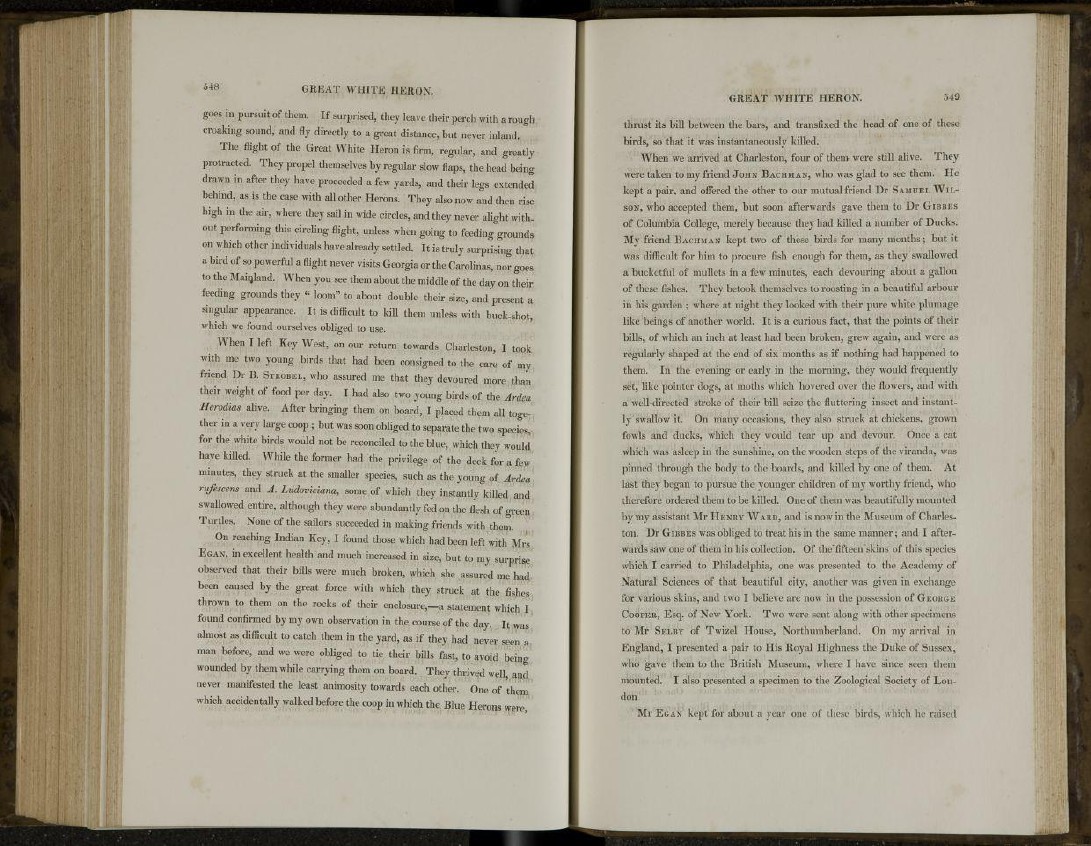
548 GREAT WHITE HERON.
goes in pursuit of them. If surprised, they leave their perch with a rough
croaking sound, and fly directly to a great distance, but never inland.
The flight of the Great White Heron is firm, regular, and greatly
protracted. They propel themselves by regular slow flaps, the head being
drawn in after they have proceeded a few yards, and their legs extended
behind, as is the case with all other Herons. They also now and then rise
high in the air, where they sail in wide circles, and they never alight without
performing this circling flight, unless when going to feeding grounds
on which other individuals have already settled. It is truly surprising that
a bird of so powerful a flight never visits Georgia or the Carolinas, nor goes
to the Mainland. When you see them about the middle of the day on their
feeding grounds they " loom" to about double their size, and present a
singular appearance. It is difficult to kill them unless with buck-shot,
which we found ourselves obliged to use.
When I left Key West, on our return towards Charleston, I took
with me two young birds that had been consigned to the care of my
friend Dr B. STROBEL, who assured me that they devoured more than
their weight of food per day. I had also two young birds of the Ardea
Herodias alive. After bringing them on board, I placed them all together
in a very large coop ; but was soon obliged to separate the two species,
for the white birds would not be reconciled to the blue, which they would
have killed. While the former had the privilege of the deck for a few
minutes, they struck at the smaller species, such as the young of Ardea
riifescens and A . Ludoviciana, some of which they instantly killed and
swallowed entire, although they were abundantly fed on the flesh of green
Turtles. None of the sailors succeeded in making friends with them.
On reaching Indian Key, I found those which had been left with Mrs
EGAN, in excellent health and much increased in size, but to my surprise
observed that their bills were much broken, which she assured me had
been caused by the great force with which they struck at the fishes
thrown to them on the rocks of their enclosure,—a statement which I
found confirmed by my own observation in the course of the day. It was
almost as difficult to catch them in the yard, as if they had never seen a
man before, and we were obliged to tie their bills fast, to avoid being
wounded by them while carrying them on board. They thrived well, and
never manifested the least animosity towards each other. One of them
which accidentally walked before the coop in which the Blue Herons were,
GREAT WHITE HERON. 549
thrust its bill between the bars, and transfixed the head of one of these
birds, so that it was instantaneously killed.
When we arrived at Charleston, four of them were still alive. They
were taken to my friend JOHN BACHMAN, who was glad to see them. He
kept a pair, and offered the other to our mutual friend Dr SAMUEL W I L SON,
who accepted them, but soon afterwards gave them to Dr GIBBES
of Columbia College, merely because they had killed a number of Ducks.
My friend BACHMAN kept two' of these birds for many months; but it
was difficult for him to procure fish enough for them, as they swallowed
a bucketful of mullets in a few minutes, each devouring about a gallon
of these fishes. They betook themselves to roosting in a beautiful arbour
in his garden ; where at night they looked with their pure white plumage
like beings of another world. It is a curious fact, that the points of their
bills, of which an inch at least had been broken, grew again, and were as
regularly shaped at the end of six months as if nothing had happened to
them. In the evening or early in the morning, they would frequently
set, like pointer dogs, at moths which hovered over the flowers, and with
a well-directed stroke of their bill seize the fluttering insect and instantly
swallow it. On many occasions, they also struck at chickens, grown
fowls and ducks, which they would tear up and devour. Once a cat
which was asleep in the sunshine, on the wooden steps of the viranda, was
pinned through the body to the boards, and killed by one of them. At
last they began to pursue the younger children of my worthy friend, who
therefore ordered them to be killed. One of them was beautifully mounted
by my assistant Mr HENRY WARD, and is now in the Museum of Charleston.
Dr GIBBES was obliged to treat his in the same manner; and I afterwards
saw one of them in his collection. Of the'fifteenskins of this species
which I carried to Philadelphia, one was presented to the Academy of
Natural Sciences of that beautiful city, another was given in exchange
for various skins, and two I believe are now in the possession of GEORGE
COOPER, Esq. of New York. Two were sent along with other specimens
to Mr SELBY of Twizel House, Northumberland. On my arrival in
England, I presented a pair to His Royal Highness the Duke of Sussex,
who gave them to the British Museum, where I have since seen them
mounted. I also presented a specimen to the Zoological Society of Lon-
,lo„
Mr EGAN kept for about a year one of these birds, which he raised